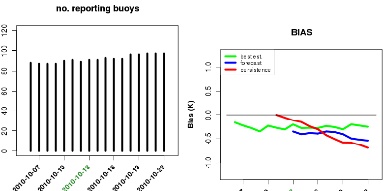- Validation
-
ARC-MFC PHY_TIDE:
» Storm surge and tides
» Near surface driftARC-MFC BGC:
» Chlorophyll a
» Mixed layer depthARC-MFC WAV:
» Wave ValidationARC-MFC PHY_ICE:
» Sea ice concentration
» Sea ice thickness
» Sea ice type
- - - - - - - -ARC-MFC PHYS:
» Validation Time Series (2016-)
» Sea Ice Concentration
» Sea Ice Thickness
» Sea Ice Type
» Sea Ice Drift
» Near Surface Drift
» Sea Surface Temperature
» Temperature and Salinity Profiles
» Sea Level Anomaly and Geostrophic Velocity
» Chlorophyll a
» Validation Time Series (2012-2015)
- - - - - - - -MyWaveWam 6km:
» Wave Validation
- - - - - - - -GLO-NEMO:
» GLO-NEMO Sea Ice Concentration
» GLO-NEMO Sea Surface Temperature
» GLO-NEMO Sea Level Anomaly and Geostrophic Velocity
- - - - - - - -
-

Validation of V2 model results from ARC-MFC

Note: ARC-MFC is presently working with transitioning to our suit of V3 models. Validation results for the V3 model results that are presently in operation are available here.
Here, we present results from validation of the model results that are produced by Copernicus Marine Service Arctic Monitoring and Forecasting Centre. Aggregated validation results are available as
- Validation time series (2020-)
- Validation time series (2016-2019)
- Validation time series (2012-2015)
Furthermore, validation results for all weekly bulletins are available for the separate forecast variables, for
- Sea ice concentration, position of ice edge
- Sea ice thickness
- Sea ice type
- Sea ice drift
- Near surface drift
- Sea surface temperature
- Temperature and salinity profiles
- Sea level anomaly and geostrophic velocity
- Chlorophyll a
Note that for sea surface temperature, validation results are available both with respect to data from drifting buoys and data from a high-quality satellite product.
All values for biases result from subtracting observed values from model results. Hence, a model will have a positive bias if e.g. model temperatures are higher than the corresponding temperature observations.
There is also an overview of the various validation regions, including information on variables with available metrics, available as
Wave model validation is performed daily:
- 6km Wave Validation (ends Feb 2020)
Validation results from Copernicus Marine Service global ocean circulation model, in order to provide product quality information that is supplementary to the results from Copernicus Marine Service Arctic MFC. Processing and computation of metrics are performed identically to the implementation for the ARC product.
- GLO-NEMO Sea Ice Concentration
- GLO-NEMO Sea surface temperature
- GLO-NEMO Sea Level Anomaly and Geostrophic Velocity
V1 Validation results
A validation report for the real-time V1 forecast system is available here (pdf).
Results from a comparison between version V0 and version V1 of the ocean circulation model is available here.
Validation results from V1 are still available as
- V1 Sea ice concentration, position of ice edge
- V1 Sea ice drift
- V1 Sea surface temperature
- V1 Temperature and salinity profiles
- V1 Sea Level Anomaly
V0 Validation results
Validation results from V0 are still available as